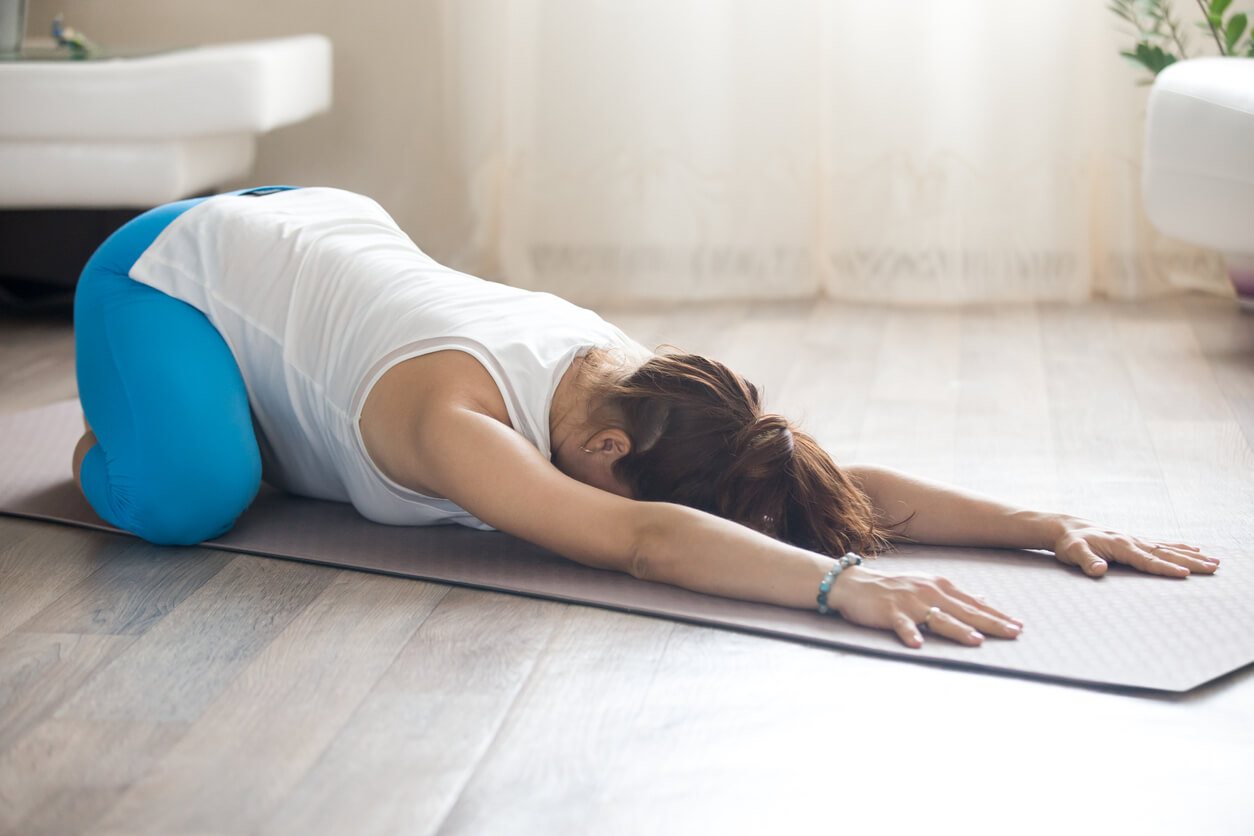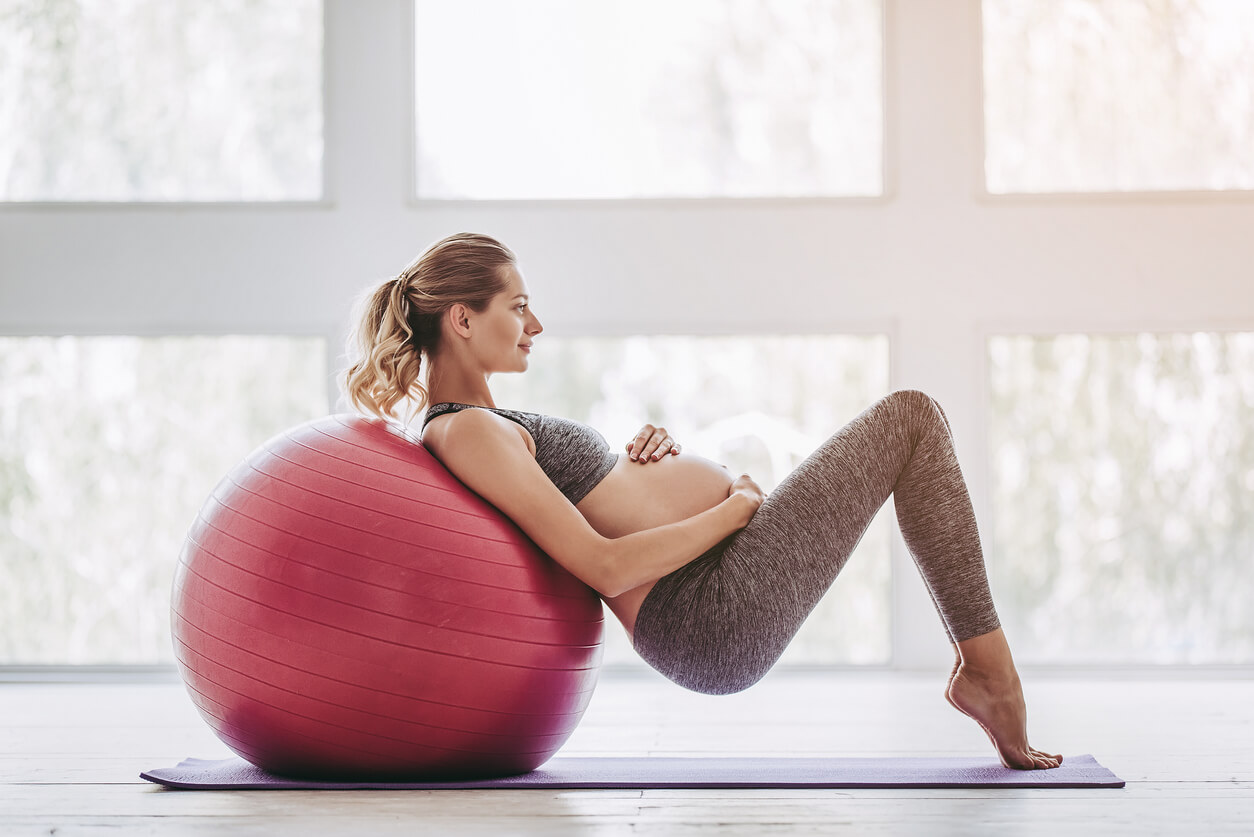4 Exercises to Make Your Baby Turn Head-Down

Many pregnant women need their baby to turn head-down at the end of gestation, as they run the risk of having a breech delivery or having to have a cesarean section. To prevent this from happening, some measures can be implemented, among which exercises stand out. Although there’s a lot of misinformation out there on the subject, getting your baby to turn upside down is much more important than you might think.
When we emphasize the importance of getting your baby to turn head-down, we’re referring to the fact that the baby isn’t positioned correctly in the mother’s uterus. Normally, by the third trimester of gestation, the fetus should be positioned headfirst toward the vagina so that a normal delivery can take place.
Here are some strategies to help your baby position itself correctly. Take note!
How to get your baby to turn head-down with exercises
In order to get your baby to turn upside down and position itself for delivery, you can use a series of exercises. Some of these have their origins in Pilates or Yoga, which is why they may be familiar to you.
It’s very important that you have your doctor’s approval to perform them and the advice of a specialist in training pregnant women. You need to make the appropriate adaptations in order to take care of your health and that of your baby.
1. Position yourself on all fours
The position of being on all fours can help the baby to turn head-down. To perform this position, you should be face down on all fours, supported by your knees and the palms of your hands.
Once in this position, bring your head-down and place it between both arms and let your arms remain as close to the floor as possible. Meanwhile, raise your buttocks slightly and hold the position for about 10 minutes.
This position is one of the exercises recommended to help adjust the baby in the uterus. However, it’s best to perform this exercise during the last weeks before delivery.

2. The cat pose
The cat pose is a well-known Yoga exercise. In this case, it stands out as a suitable alternative for babies to turn around inside the uterus.
To perform it, you must position yourself face down, also on all fours, just as in the previous exercise. You can rest your arms on the floor or in a higher position, according to your comfort.
Next, you should bring your head between your arms, tuck your pelvis and arch your back while inhaling, as if you were an “angry cat”. Hold this position for a few seconds along with the air. When you finish, return to the starting position and gradually expel all the air.
3. Pelvic lift with and without support
The pelvic lift also stands out as one of the exercises suitable for helping babies turn head-down in the uterus. However, as this body posture influences blood circulation, it’s also best to perform it for short periods of time.
There are two ways to perform this exercise:
- The first is without support, only with the body on a comfortable, flat surface. You should lie on your back with your legs bent, the soles of your feet fully supported, as well as your back and arms. Then, raise your pelvis in a controlled and harmonious movement. Take it as high as you can and make sure it’s aligned with your back and head. Hold the position for a few seconds.
- The second way to perform it is with the support of a Pilates ball or fitball. Rest your back on the ball, bend your legs and then put the soles of your feet on the floor. Your arms will be used to hold onto the ball.
In this position, try to raise your pelvis while pressing with your feet. If you feel able, try to support your toes so that the elevation is greater. Try to hold the position for a few seconds and rest.

4. Pelvic rotations
Pelvic rotations are one of the easiest exercises to help your baby turn around in the womb.
Just sit on the Pilates ball with a firm posture: Back straight, soles of your feet fully supported, and arms on your thighs. From there, start moving your pelvis in circles, slowly to one side and the other. Try to make the movement controlled and harmonious.
Exercises to turn your baby around, be careful how you do them!
The exercises mentioned above can help the baby turn around inside the uterus. However, it’s not guaranteed to work in all cases. This doesn’t mean that you can’t try them.
In addition, try to do them only if your gynecologist authorizes them. Try not to go against the grain, as you may injure yourself or your future baby. In addition, you need to have the supervision of a professional in pregnancy training at all times.
Last but not least, you can also choose to use music or talk to your baby. This type of connection, on many occasions, favors the well-being of the little one inside the uterus.
Many pregnant women need their baby to turn head-down at the end of gestation, as they run the risk of having a breech delivery or having to have a cesarean section. To prevent this from happening, some measures can be implemented, among which exercises stand out. Although there’s a lot of misinformation out there on the subject, getting your baby to turn upside down is much more important than you might think.
When we emphasize the importance of getting your baby to turn head-down, we’re referring to the fact that the baby isn’t positioned correctly in the mother’s uterus. Normally, by the third trimester of gestation, the fetus should be positioned headfirst toward the vagina so that a normal delivery can take place.
Here are some strategies to help your baby position itself correctly. Take note!
How to get your baby to turn head-down with exercises
In order to get your baby to turn upside down and position itself for delivery, you can use a series of exercises. Some of these have their origins in Pilates or Yoga, which is why they may be familiar to you.
It’s very important that you have your doctor’s approval to perform them and the advice of a specialist in training pregnant women. You need to make the appropriate adaptations in order to take care of your health and that of your baby.
1. Position yourself on all fours
The position of being on all fours can help the baby to turn head-down. To perform this position, you should be face down on all fours, supported by your knees and the palms of your hands.
Once in this position, bring your head-down and place it between both arms and let your arms remain as close to the floor as possible. Meanwhile, raise your buttocks slightly and hold the position for about 10 minutes.
This position is one of the exercises recommended to help adjust the baby in the uterus. However, it’s best to perform this exercise during the last weeks before delivery.

2. The cat pose
The cat pose is a well-known Yoga exercise. In this case, it stands out as a suitable alternative for babies to turn around inside the uterus.
To perform it, you must position yourself face down, also on all fours, just as in the previous exercise. You can rest your arms on the floor or in a higher position, according to your comfort.
Next, you should bring your head between your arms, tuck your pelvis and arch your back while inhaling, as if you were an “angry cat”. Hold this position for a few seconds along with the air. When you finish, return to the starting position and gradually expel all the air.
3. Pelvic lift with and without support
The pelvic lift also stands out as one of the exercises suitable for helping babies turn head-down in the uterus. However, as this body posture influences blood circulation, it’s also best to perform it for short periods of time.
There are two ways to perform this exercise:
- The first is without support, only with the body on a comfortable, flat surface. You should lie on your back with your legs bent, the soles of your feet fully supported, as well as your back and arms. Then, raise your pelvis in a controlled and harmonious movement. Take it as high as you can and make sure it’s aligned with your back and head. Hold the position for a few seconds.
- The second way to perform it is with the support of a Pilates ball or fitball. Rest your back on the ball, bend your legs and then put the soles of your feet on the floor. Your arms will be used to hold onto the ball.
In this position, try to raise your pelvis while pressing with your feet. If you feel able, try to support your toes so that the elevation is greater. Try to hold the position for a few seconds and rest.

4. Pelvic rotations
Pelvic rotations are one of the easiest exercises to help your baby turn around in the womb.
Just sit on the Pilates ball with a firm posture: Back straight, soles of your feet fully supported, and arms on your thighs. From there, start moving your pelvis in circles, slowly to one side and the other. Try to make the movement controlled and harmonious.
Exercises to turn your baby around, be careful how you do them!
The exercises mentioned above can help the baby turn around inside the uterus. However, it’s not guaranteed to work in all cases. This doesn’t mean that you can’t try them.
In addition, try to do them only if your gynecologist authorizes them. Try not to go against the grain, as you may injure yourself or your future baby. In addition, you need to have the supervision of a professional in pregnancy training at all times.
Last but not least, you can also choose to use music or talk to your baby. This type of connection, on many occasions, favors the well-being of the little one inside the uterus.
All cited sources were thoroughly reviewed by our team to ensure their quality, reliability, currency, and validity. The bibliography of this article was considered reliable and of academic or scientific accuracy.
- Moldenhauer, J. (2020). Posición y presentación anómalas del feto. MD, Children’s Hospital of Philadelphia. https://www.msdmanuals.com/es-es/hogar/salud-femenina/complicaciones-del-parto/posici%C3%B3n-y-presentaci%C3%B3n-an%C3%B3malas-del-feto
- Cluver C, Gyte GML, Sinclair M, Dowswell T, Hofmeyr G. Interventions for helping to turn term breech babies to head first presentation when using external cephalic version. Cochrane Database of Systematic Reviews 2015, Issue 2. Art. No.: CD000184. DOI: 10.1002/14651858.CD000184.pub4. Disponible en: https://www.cochrane.org/es/CD000184/PREG_formas-para-ayudar-rotar-al-feto-de-presentacion-podalica-cefalica-al-final-del-embarazo
This text is provided for informational purposes only and does not replace consultation with a professional. If in doubt, consult your specialist.








